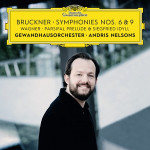|
Back
06/02/2019
Anton Bruckner: Symphony n° 6 in A major, WAB 106 – Symphony n° 9 in D minor, WAB 109
Richard Wagner: Siegfried-Idyll, WWV 103 – Parsifal: Prelude to Act I, WWV 111
Gewandhausorchester Leipzig, Andris Nelsons (conductor)
Recording: Gewandhaus, Leipzig, Germany (December 2018) – 152’
Deutsche Grammophon 0289 483 6659 0 (Distributed by Universal Music Group) – Booklet in English and German

   
The present double-bill is the first installment of Andris Nelsons’ ongoing Bruckner cycle from Leipzig that I have heard. One wonders why Deutsche Grammophon decided to issue the Sixth and Ninth Symphonies together in a double package. I had initially hoped that this was to justify the inclusion of one of the recent completions of the latter’s finale, which would surely force that work to take up two discs. As it happens, Nelsons favors the traditional three-movement version of the Ninth, and so we have room for two Wagner fillers, both given warm, singing readings that never threaten to bog down in pseudo-profundity.
The Bruckner which takes up the bulk of this set gives us a taste of the young star conductor’s strengths and weaknesses alike, although I am pleased to say that here the former generally outweigh the latter, and by some distance. In my experience, what has kept Nelsons (so far) from being a truly world-class conductor is a merely fitful ability to sustain momentum. This manifests itself variously in fussy phrasing that breaks up the long line and in a general, if slight, lack of incisiveness. In the Bruckner Sixth under review, some of the composer’s trademark sequences and ostinatos threaten to become static, whether through mannered phrasing or sheer inertia. Furthermore, my favorite conductors on record in this work—Klemperer and Joseph Keilberth—bring a touch more urgency and character overall.
Nelsons’ ace in the hole may well be his magnificent Leipzig orchestra, which as recorded here (in concert, no less) is beyond criticism: its silken strings, full-bodied yet lithe, and warmly burnished brass and horns make for sheer listening delight and, for the most part, help Nelsons to make a persuasive case for his view of the score, which does not skirt the dramatic elements but is essentially gentle and refined. The Sixth is not among the most popular Bruckner, which is a shame. As difficult as it can be to pull off convincingly, in the right hands it sounds like the masterpiece I think it really is. The problem, it seems to me, is that in spite of the large Wagnerian orchestra in use, Bruckner is not aiming here for his usual sense of cosmic grandeur here, most of the time at any rate; in light of this, the frequent sense of nervousness (simply consider the “Morse-code” opening) can make it a challenge to keep the music airborne. Karajan’s recording is often dismissed, and while I think it better than its reputation, the more subtle charms of the music are not always well-served by the somewhat monolithic loftiness of the generally great Bruckner conductor’s approach here. This is especially true of the slow movement, which is more of a love song and less of a meditation or spiritual battle than Bruckner’s more famous adagios and does not respond too well to Karajan’s more solemn view.
Like Karajan, Nelsons takes the slow movement quite slowly, but the young Latvian conductor is more down-to-earth and attentive to detail here than the late Austrian was, even if a bit more “kick” might have been welcome. Yet it is in the serene majesty of the first movement’s coda, and in the entire finale, which flows along logically and compellingly, that Nelsons is perhaps most impressive and effective. This is not perfect, but it stands as a worthwhile, even notable entry in a catalog that is not exactly saturated with great Bruckner Sixths, and for orchestral beauty and refinement it comfortably surpasses my preferences mentioned above.
The competition is stiffer in the Ninth, which has received considerably greater attention from most conductors, and Nelsons’ reading began somewhat less than auspiciously to my ears with some labored phrasing in the build-up to the first climax. Yet before long he settled into a more natural grip on the music, and from here on in all was smooth sailing. This is arguably Bruckner’s darkest symphony, and I tend to most appreciate conductors who respect the turbulence in the score without letting it become altogether oppressive. Nelsons manages to comfortably balance lyric sweetness with visceral intensity; the famous “Adagio” is communicative without becoming overwhelming. (Again, the orchestra proves a tremendous asset.) As in the Sixth, the expression is gentler and more down-to-earth than with Karajan, for better or for worse. I would not make the same claim for all of the Bruckner Symphonies—and Nelsons cannot always match Karajan’s sense of sweep—but here I think it may be for the better. This is at minimum a very fine Ninth. This is not a Bruckner set for the ages—it too frequently resembles a work-in-progress—yet one cannot but admire its best elements.
Samuel Wigutow
|